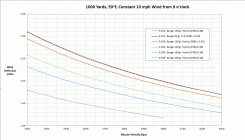If this topic has been discussed I apologize for this post.
I hear this a lot lately that if two bullets, different caliber/weight, but with same BC are fired at same velocity the bullet that is heavier(bigger caliber) will drift less.
For example Berger 185 fired from 308 at 2750 fps will get less affected by wind compared to Berger 90 VLD out of 223 at 2750 fps, even though G7 BC is almost the same. Ballistic solution suggests they should both drift the same but some 'experts' disagree.
So my question is, isn't BC supposed to include all that? The way I thought was that BC is the final number that tells what bullet will do in flight. Is there more to it? Extra weight/momentum has something to do with flight characteristics also?
Brian I really appreciate your help that we all get through this forum.
Thanks
Av
I hear this a lot lately that if two bullets, different caliber/weight, but with same BC are fired at same velocity the bullet that is heavier(bigger caliber) will drift less.
For example Berger 185 fired from 308 at 2750 fps will get less affected by wind compared to Berger 90 VLD out of 223 at 2750 fps, even though G7 BC is almost the same. Ballistic solution suggests they should both drift the same but some 'experts' disagree.
So my question is, isn't BC supposed to include all that? The way I thought was that BC is the final number that tells what bullet will do in flight. Is there more to it? Extra weight/momentum has something to do with flight characteristics also?
Brian I really appreciate your help that we all get through this forum.
Thanks
Av











